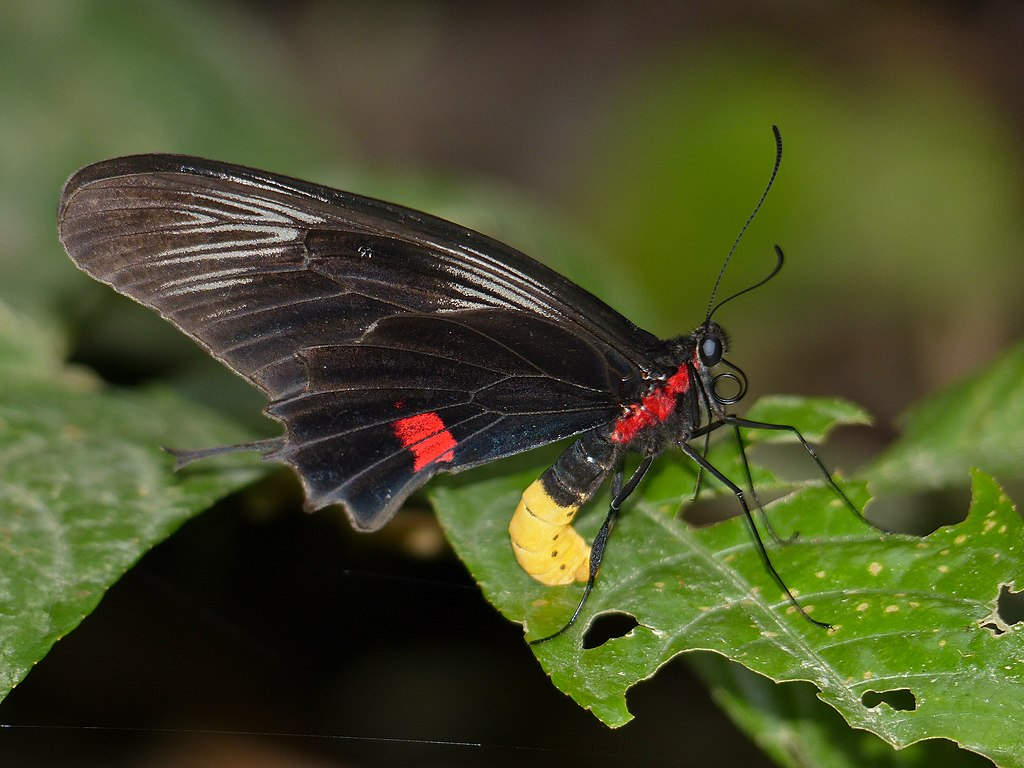"Yellow-Bodied Clubtail" is the English nickname for Losaria (also known as Atrophaneura, Balignina, Pachliopta, Parides, or Papilio) neptunus, one of the tropical Asian swallowtail butterflies with "tails" on their hind wings that are shaped like clubs or spoons.
Photo donated to Wikipedia By Bernard DUPONT from FRANCE - Yellow-bodied Club-tail (Losaria neptunus doris), CC BY-SA 2.0, https://commons.wikimedia.org/w/index.php?curid=40726306
Linnaeus's Latin name for the swallowtails was simple and logical. He saw swallowtails as the quintessential butterflies, so he called them all Papilio, which was Latin for "butterfly." Later the dark-winged, red-bodied Asian swallowtails got their own genus name, Atrophaneura, which seems to be Greek for "black wing nerves," their most conspicuous feature. But why, when the "clubtail" species were given their own genus name, was that name Losaria? Online sources don't know. Google shows several sites that list "Losaria" as a name, derived from a fictional character, but fails to find any meaning for the word in Latin or Greek. Census records list "Losaria" as a family name, apparently of Spanish origin, so it would be Lo-sah-ree-a. That's as far as Google goes.
Photo from Phuket Nature Tours: http://www.phuketnaturetours.com/Pages/iframephotos.php?level=tribe&choice=60100200030&ordername=Papilionoidea&orderid=60&familyname=Papilionidae&familyid=6010&subfamilyname=Papilioninae&subfamilyid=6010020&tribename=Atrophaneura . Their site shows other red-bodied swallowtails of Thailand and documents, among other things, that while mating some neptunus seem comfortable hanging completely upside down.
Neptunus is easier to understand. The early naturalists named the first swallowtails they identified after characters in ancient literature. Neptunus or Neptune was a god of the sea, actually worshipped by seafarers. Many other things, including a planet, have been named after him.
Some of the subspecies' names have also been clearly explained: L.n. manasukkiti was named after a scientist whose name was Mana Sukkit, as explained in one scholarly article recent enough to have been published online.
L.n. fehri was named after a Professor Fehr:
Sumatra, padanganus, and dacasini identify places where these subspecies were identified and named.
Photo of P.n. dacasini from https://philippinelepidopt.wixsite.com/butterflies/papilioninae-troidini, which also shows photos of several swallowtail and birdwing butterflies found in the Philippine islands, and has its own photo documentation of neptunus mating while hanging upside down.
For most of the species in this group the rule is that females are a little bigger than males, but in neptunus males have longer forewings and wing "tails" than females.
The wingspread is about four inches, usually a little more, occasionally a little less. There is the usual range of individual variation within about a half-dozen sub-species types, but most butterflies in this species have those shadowy-looking patches at the ends and across the middles of the forewings. The lighter color between the shadows can look like white bands.
The butterflies live in forests at low elevations in the mountains, and typically fly in March and again in May or June.
Ellen Tan found this neptunus and many other butterflies, including close-up shots of some adorable smaller ones, on a nature walk in Johor:
Although the butterfly is not rare, its life cycle remains undocumented on the Internet. Presumably that would be because it's a typical red-bodied swallowtail: eggs like little beads hatch into bumpy-textured caterpillars, which then pupate in a flattened, pale shape that looks like a wilted leaf at a distance. Neptunus is one of the minority of species in this genus that sometimes eat something other than a vine in the genus Aristolochia; when they do, it's Thottea. None of these butterflies eats the leaves of any flower, fruit, or vegetable normally cultivated by humans.
Neptunus is noted as rare in the places where it lives, but is not believed to be in immediate danger of extinction.





No comments:
Post a Comment